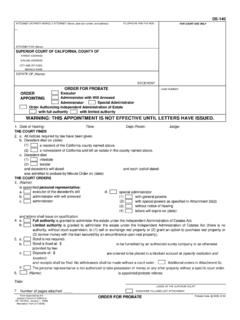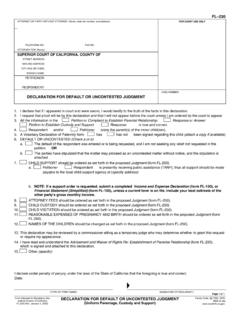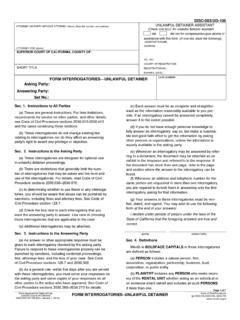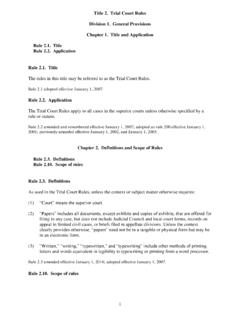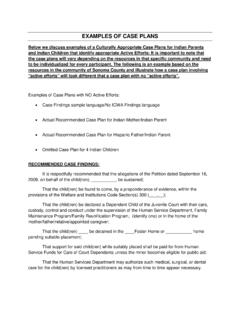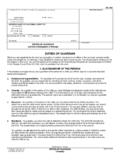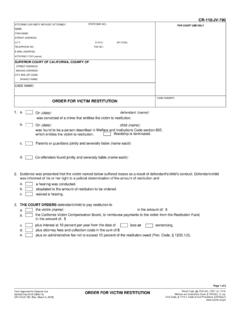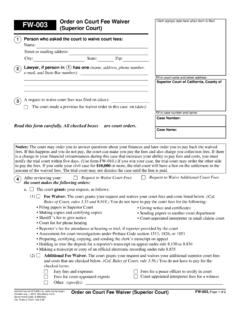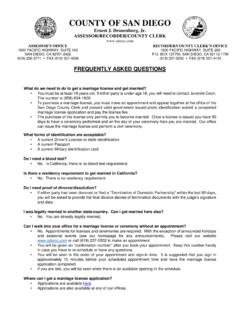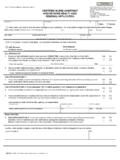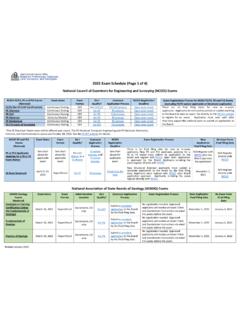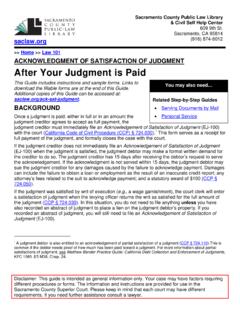Transcription of 22 CERTIFIED FOR PUBLICATION
1 Filed 1/7/22 CERTIFIED FOR PUBLICATION IN THE COURT OF APPEAL OF THE STATE OF california SECOND APPELLATE DISTRICT DIVISION THREE LOUIS LOZANO et al., Plaintiffs and Appellants, v. CITY OF LOS ANGELES et al., Defendants and Respondents. B307412 Los Angeles County Super. Ct. No. 19 STCP00168 APPEAL from a judgment of the Superior Court of Los Angeles County, Mary H. Strobel, Judge. Affirmed. Law Offices of Gregory G. Yacoubian and Gregory G. Yacoubian for Plaintiffs and Appellants. Michael N. Feuer, City Attorney, Carlos De La Guerra, Assistant City Attorney, and Paul L. Winnemore, Deputy City Attorney, for Defendants and Respondents. _____ 2 Louis Lozano and Eric Mitchell (petitioners), former police officers for the City of Los Angeles (the City), filed a petition for writ of administrative mandate challenging the City s decision to terminate their employment.
2 A board of rights found petitioners guilty on multiple counts of misconduct, based in part on a digital in-car video system (DICVS) recording that captured petitioners willfully abdicating their duty to assist a commanding officer s response to a robbery in progress and playing a Pok mon mobile phone game while on duty. Petitioners contend the City proceeded in a manner contrary to the law by using the DICVS recording in their disciplinary proceeding and by denying them the protections of the Public Safety Officers Procedural Bill of Rights Act (Gov. Code, 3300 et seq.) (POBRA or the Act).1 The trial court denied their petition. We affirm. FACTS AND PROCEDURAL HISTORY Consistent with our standard of review, we state the facts established by the evidence at the board of rights hearing in the light most favorable to the trial court s factual findings, drawing all reasonable inferences and resolving all evidentiary conflicts to uphold the court s judgment.
3 (Molina v. Board of Administration, etc. (2011) 200 53, 61 (Molina); Steinert v. City of Covina (2006) 146 458, 462, 465 (Steinert); Jaramillo v. County of Orange (2011) 200 811, 815 (Jaramillo).) 1 Statutory references are to the Government Code, unless otherwise designated 3 1. Radio Call for a Robbery in Progress at the Crenshaw Mall On Saturday, April 15, 2017, petitioners were working as partners assigned to a foot beat patrol in the Los Angeles Police Department (LAPD or Department) Southwest Division. Petitioners primary responsibilities included providing community services and addressing quality of life issues in the Crenshaw Corridor and Leimert Park area. Sergeant Jose Gomez was petitioners patrol supervisor that day. Captain Darnell Davenport was the patrol commanding officer for the Southwest Division. It was a busy Saturday in the Southwest Division there were more calls than police cars available to respond and there had been a homicide earlier in the day.
4 While en route to the homicide scene, Captain Davenport heard a radio call for a 211 [robbery] in progress with multiple suspects at the Macy s in the Crenshaw Mall. When the call came in, the Captain could see the Macy s from where he was stopped, and to his right he noticed a police car tucked back in an alley just feet away. He was not able to identify the unit, and when the unit did not respond to the radio call, the Captain assumed it might be a traffic unit or a unit from a different division using a different radio frequency. Consequently, Captain Davenport decided he would respond to the call and notified communications he was going Code 6 on the call , responding to the location of the robbery. At around the same time, the Captain saw the police car start to back up down the alley, then negotiate a left-hand turn to leave the area. Sergeant Gomez was in the watch commander s office when the robbery in progress call went out.
5 He described the 4 next five to seven minutes as chaotic, with communications sending constant updates as to what was happening at Macy s. As Captain Davenport went Code 6 on the robbery, Sergeant Gomez looked at the watch commander s board and saw petitioners unit was Code 6 (located) in the Crenshaw Corridor. He attempted to radio petitioners unit and requested they respond to the Crenshaw Mall to assist the Captain, but he received no response. Simultaneously, a unit broke away from the homicide crime scene and went Code 3 (red lights and sirens) from across the division to assist at the mall. Sergeant Gomez queried communications again for petitioners response. Communications replied, No, and that was it. 2. Sergeant Gomez s Meeting with Petitioners When Sergeant Gomez returned to the station he realized petitioners had initiated their Code 6 on the Crenshaw Corridor at approximately the same time that Captain Davenport went Code 6 on the robbery in progress.
6 This seemed peculiar to him and he wanted to find out what happened. Sergeant Gomez contacted petitioners and arranged to meet with them later that evening at a 7-Eleven parking lot where they were conducting an illegal merchandise investigation. When the investigation concluded, the Sergeant asked petitioners to clarify what their duties were as the foot beat patrol car. Officer Lozano explained their primary responsibility was community relations with citizens and businesspeople, adding the main issues are Leimert Park. After discussing their duties, Sergeant Gomez asked petitioners if they had heard a call for backup at Crenshaw Mall for a 211. Officer Mitchell said he had not, while Officer Lozano said he heard Captain Davenport was Code 6 at the Crenshaw 5 Mall but he did not hear a request for backup. Sergeant Gomez counseled petitioners that we have to listen to the radio, [i]t s what our livelihood and our safety depends on, and he asked them if their radios were working.
7 Officer Mitchell responded that there was a lot of music and it was really loud in the park .. [,] especially on Saturdays. Officer Lozano concurred, adding, we have no control over the [public announcement] system and all the loud noise, it was loud. Sergeant Gomez acknowledged he couldn t dispute that, and he advised petitioners to move to a location where [they] could hear the radio if they found themselves in a loud area in the future. Sergeant Gomez asked petitioners if they had any questions regarding his concerns and he reiterated that the best practice was to be in a location where they could hear the radio. In his testimony to the board of rights, the Sergeant explained: At that point, my understanding was that the [robbery] call wasn t heard because they were at the park. And like I said, I could not dispute that. He concluded the meeting by advising petitioners that he was counseling them for not listening to the radio and left it at that.
8 3. The DICVS Recording and Misconduct Investigation Sergeant Gomez was still uneasy about the timing of petitioners Code 6 on the Crenshaw Corridor when he came into work the following day. It then dawned on him to review their patrol unit s DICVS recording to find out what they do on their average day. Sergeant Gomez s review of the DICVS recording revealed new and disturbing facts: It had been petitioners patrol unit that Captain Davenport saw in the alley only a short distance from the mall; petitioners did hear the radio call about a robbery 6 in progress; they discussed the call and whether they should assist Captain Davenport; and they went Code 6 on the Crenshaw Corridor to conceal that they had decided not to respond to the call. The DICVS recording disclosed that, immediately after Captain Davenport s Code 6 broadcast, Officer Lozano asked Officer Mitchell if they were Code 6 on the Crenshaw Corridor or on the corner near the mall where they were parked.
9 Mitchell responded they were [a]t the corner and noted the broadcast radio call was Davenport. Lozano then instructed Mitchell to put them Code 6 at the corridor, adding (after some laughter) regarding Captain Davenport, I don t want to be his help. Petitioners unit then moved backwards through the alley and turned away from the mall, as Captain Davenport had observed. For the next several minutes the DICVS captured continued radio traffic regarding the robbery and pursuit of multiple suspects. After communications made a second attempt to contact petitioners, Officer Lozano asked if they should ask [communications] if there s a message. Officer Mitchell replied, It s up to you. Whatever you think. I don t want them to think we re not paying attention to the radio. Lozano responded, Aw, screw it. Petitioners made no attempt to respond over the radio when their unit was called.
10 Sergeant Gomez notified the watch commander about petitioners conduct and what the DICVS recording disclosed. His concerns were forwarded up the chain of command and the Sergeant was ultimately instructed to prepare the face sheet of a misconduct complaint against petitioners. Detective Tracy McClanahan conducted the misconduct investigation, focusing on allegations that petitioners failed 7 to respond to a robbery in progress call, made false statements to a supervisor, and neglected to handle a radio call. Her investigation primarily involved multiple reviews of the DICVS recording and interviews with Captain Davenport, Sergeant Gomez, Commander Gerald Woodyard (who oversaw the foot beat units), and Officers Lozano and Mitchell. Officers Lozano and Mitchell told Detective McClanahan they did not respond to the robbery in progress call because Captain Davenport did not request backup and because they were instructed to stay in their assigned area of the Crenshaw Corridor.
